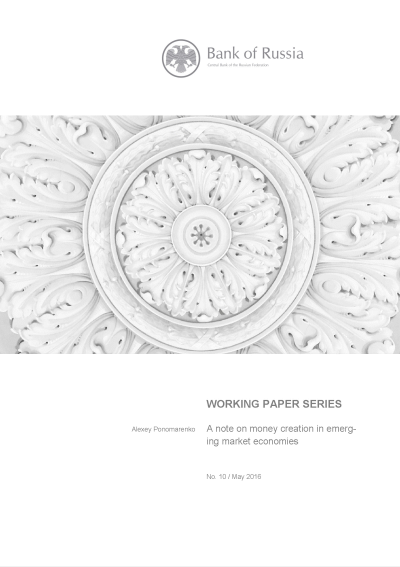Книги
A note on money creation in emerging market economies
Ponomarenko, A.A. A note on money creation in emerging market economies / A. A. Ponomarenko; The Central Bank of the Russian Federation. — Moscow : Bank of Russia, 2016. — 23 p.: il.. — (Working Paper Series; № 10 / may). — References: p. 20-21.
Аннотация
Money is created by bank lending. When a bank grants a loan, it books the loan as an asset and the newly created deposit as a liability. Therefore, when banks lend to borrowers, they thereby create deposits (initially held by the borrowers). Deposits may later be used as payment media and thus may be spread among customers of different banks. This mechanism, which is present in a number of comprehensive (if somewhat heterogeneous) theoretical economic models (Goodley and Lavoie (2007), Jakab and Kumhof (2015), Brunnermeier and Sannikov (2016), Hanson et al. (2015)) and has found empirical support (Badarudin et al. (2013), Werner (2014)), is widely accepted as state of the art in monetary analysis (ECB (2011), McLeay et al. (2014), Borio and Disyatat (2015)). The concept is crucial for understanding monetary policy transmis-sion. Money being a by-product of credit, however, shifts the focus of monetary analysis from the liability side of the banking system to the asset side (see e.g. Friedman (2012), Turner (2013)), i.e. from money to credit. Accordingly, credit extension creates new purchasing power and is thus crucial for economic analysis. The creation of various combinations of instruments on the liability side of the banking system balance sheet becomes irrelevant in this context.
Ключевые слова
- #банк россии
- #графики
- #денежное предложение
- #денежные агрегаты
- #денежные потоки
- #департамент исследований и прогнозирования
- #издания банка россии
- #пономаренко а.а.
- #потоки капитала
- #работы сотрудников
- #россия
- #таблицы
- #формирующиеся рынки
- #центральный аппарат
- #экономические исследования
- #эмпирический анализ
- #английский язык
-
УДК:336.7
Отзывы читателей
0
